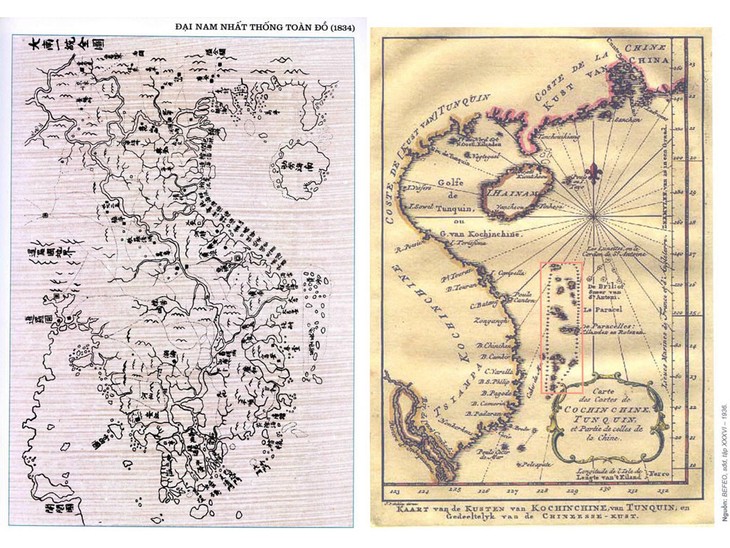(VOVWORLD) - China’s establishment of the so-called districts of “Xisha” and “Nansha” in “Sansha” city, Hainan province, violates international law and Vietnam’s sovereignty rights over Truong Sa (Spratly) and Hoang Sa (Paracel) archipelagos. Vietnam long ago established its undeniable sovereignty rights over these two archipelagos.
 The Complete Map of Unified Dai Nam by Phan Huy Chu (1834) and a map of Vietnam drew by Westerners in 1749 are evidence of Vietnam's sovereignty over Truong Sa and Hoang Sa archipelagos. The Complete Map of Unified Dai Nam by Phan Huy Chu (1834) and a map of Vietnam drew by Westerners in 1749 are evidence of Vietnam's sovereignty over Truong Sa and Hoang Sa archipelagos. |
According to the Chinese Ministry of Civil Affairs, the so-called "Xisha island district" will be located on Phu Lam island in Vietnam’s Hoang Sa archipelago. The head administrative office of the so-called “Nansha district” will be located on Fiery Cross Reef in Vietnam’s Truong Sa archipelago. China’s decision to establish these districts has no legal basis because Truong Sa and Hoang Sa archipelagos belong indisputably in their entirety to Vietnam.
Evidence contained in historical documents and continuous management
Vietnam has exercised its sovereignty over Truong Sa and Hoang Sa archipelagos throughout history, consistent with all international norms and laws regarding national territorial sovereignty. Evidence has been recorded in Vietnamese and Chinese historical documents through multiple feudal regimes and in many western countries, including France, Portugal, and Spain.
Vietnamese maps drawn in the 17th century called the two archipelagos “Bai Cat Vang” (Golden Sandbank) of Binh Son district, Quang Ngai province. Many historical documents of Vietnam in the 17th century, the Miscellaneous Chronicles of Pacification in the Border Area (1776), The Prequel Records of Dai Nam (1844-1848), History of the Unified Dai Nam (– 1865-1875), and imperial records of the Nguyen Dynasty (1802-1945), recorded that the Vietnamese state sent Hoang Sa navy fleets to exploit the two archipelagos.
Numerous old documents and maps of foreign countries contain evidence of Vietnam’s sovereignty over the Hoang Sa and Truong Sa archipelagos. The most important event confirming Vietnam's claim of sovereignty over the two archipelagos occurred in 1816, when King Gia Long sent troops to hoist a Vietnamese flag in Hoang Sa archipelago. Lords of the Nguyen dynasty regularly sent missions to manage and exploit Hoang Sa and Truong Sa archipelagos. Other Vietnamese feudal regimes organized Hoang Sa and Bac Hai naval fleets to exercise Vietnam’s sovereignty and exploit the two archipelagos. In 1884 the French administration in Indo-China continued to observe and strengthen Vietnam’s sovereignty over Hoang Sa and Truong Sa archipelagos.
Illegal to attempt to change sovereignty by force
Evidence has proved Vietnam’s indisputable sovereignty over Hoang Sa and Truong Sa archipelagos. China blatantly violated the UN Charter by using armed force in 1974 to illegally occupy Hoang Sa archipelago. This does not give China any legal status in the archipelago.
Tran Duy Hai, former Deputy Head of the National Border Committee of the Vietnamese Ministry of Foreign Affairs, said: “When the French withdrew from Vietnam, they handed over the management of the Hoang Sa archipelago to the Republic of Vietnam and the Republic of Vietnam administration continued to manage and maintain a military presence on the archipelago. China took advantage of the war to attack the Republic of Vietnam’s forces in Hoang Sa but China cannot establish sovereignty over the archipelago simply by using armed force to invade it.”
To preserve regional peace and respect productive bilateral relations, Vietnam has always insisted on peacefully resolving all disputes through dialogue.
Under a 6-point Agreement on basic principles guiding the settlement of maritime issues between the two countries, signed in 2011, China, too, has committed to consistently pursue friendly consultations to resolve maritime issues and make the East Sea (also known as the South China Sea) a sea of peace, friendship, and cooperation. But China’s actions are at odds with this commitment.
Hoang Ngoc Giao, Director of the Institute for Policy, Law and Development Studies, said: “China has repeatedly said that it respects international law, but its actions do not accord with its words. China has forfeited any claim to international prestige, status, or responsibility. The international community should know it.”
Respecting and abiding by international law is of ultimate importance for any country big or small. China, as one of the world’s great powers, must do its part to ensure regional peace, stability, and security by complying with international law and the UN Convention on the Law of the Sea.
China’s attempt to establish a “Xisha district” and a “Nansha” district in Hainan province flouts international laws and norms and China’s own commitments. It has undermined the trust of China’s neighbors and could lead to dangerous consequences for the region and the world.